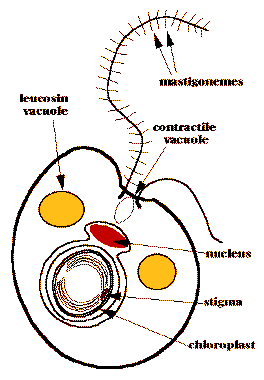







 What makes a chromist a chromist? Tubular mastigonemes. In other
words, most chromists, at some stage of their life cycles, have two
eukaryote-type flagella, or undulipodia, one of which is covered with
tubular hairs branching from it, and a second flagellum without these hairs.
Both flagella are attached to one side of the cell, rather than to the
"front" or "back" end of the cell. Even multicellular chromists, like
brown algae
and water molds,
produce flagellated zoospores of this type.
What makes a chromist a chromist? Tubular mastigonemes. In other
words, most chromists, at some stage of their life cycles, have two
eukaryote-type flagella, or undulipodia, one of which is covered with
tubular hairs branching from it, and a second flagellum without these hairs.
Both flagella are attached to one side of the cell, rather than to the
"front" or "back" end of the cell. Even multicellular chromists, like
brown algae
and water molds,
produce flagellated zoospores of this type.
Many chromists are photosynthetic; those that are have a particular form of chlorophyll, chlorophyll c, which is not found in most other photosynthetic organisms. Most also contain carotenoid pigments, such as the brown pigment fucoxanthin, that give the cells a yellow, orange, or brown color. Food manufactured by these organisms may be stored for reserve energy in the form of the oil leucosin or the polysaccharide laminarin; chromists do not manufacture starch as plants do. The chroroplast and nucleus are typically surrounded by a common membrane; the chloroplast contains a light- sensitive "eyespot" of pigment granules, the stigma. The diagram of a simple chromist shown here shows the location of these features.
A third character that a number of chromists have in common is the manufacture of silica or calcium carbonate skeletons of various shapes from their Golgi apparatus, although not all chromists can do this. Those that can form silica skeletons, such as the diatoms and silicoflagellates, or skeletons of calcium carbonate, such as the coccolithophorids, may be extremely abundant in the fossil record. Many of the chromists which do not deposit skeletons surround their cells with a wall of cellulosic compounds, which gives the organism strucutre and rigidity, while remaining flexible.
Chromistans have evolved multicellularity independently of plants and animals. Basal chromists are primarily single-celled throughout their life history. Several groups, including diatoms and chrysophytes, have species that live colonially; several cells live together, but each function an a separate entity. Many oomycetes live as filamentous networks of cells, giving them a fungal-like appearance. The most complex anatomy among chromists, however, is that of the large kelps. Many kelps have specilized tissue regions that differentiate from surrounding cells, even producing a kind of conductive tissue in a few species.
For more detailed information on the morphology of one chromist in particular, the chrysomonad Poterioochromonas, click to visit the Protist Image Database at the University of Montreal.


